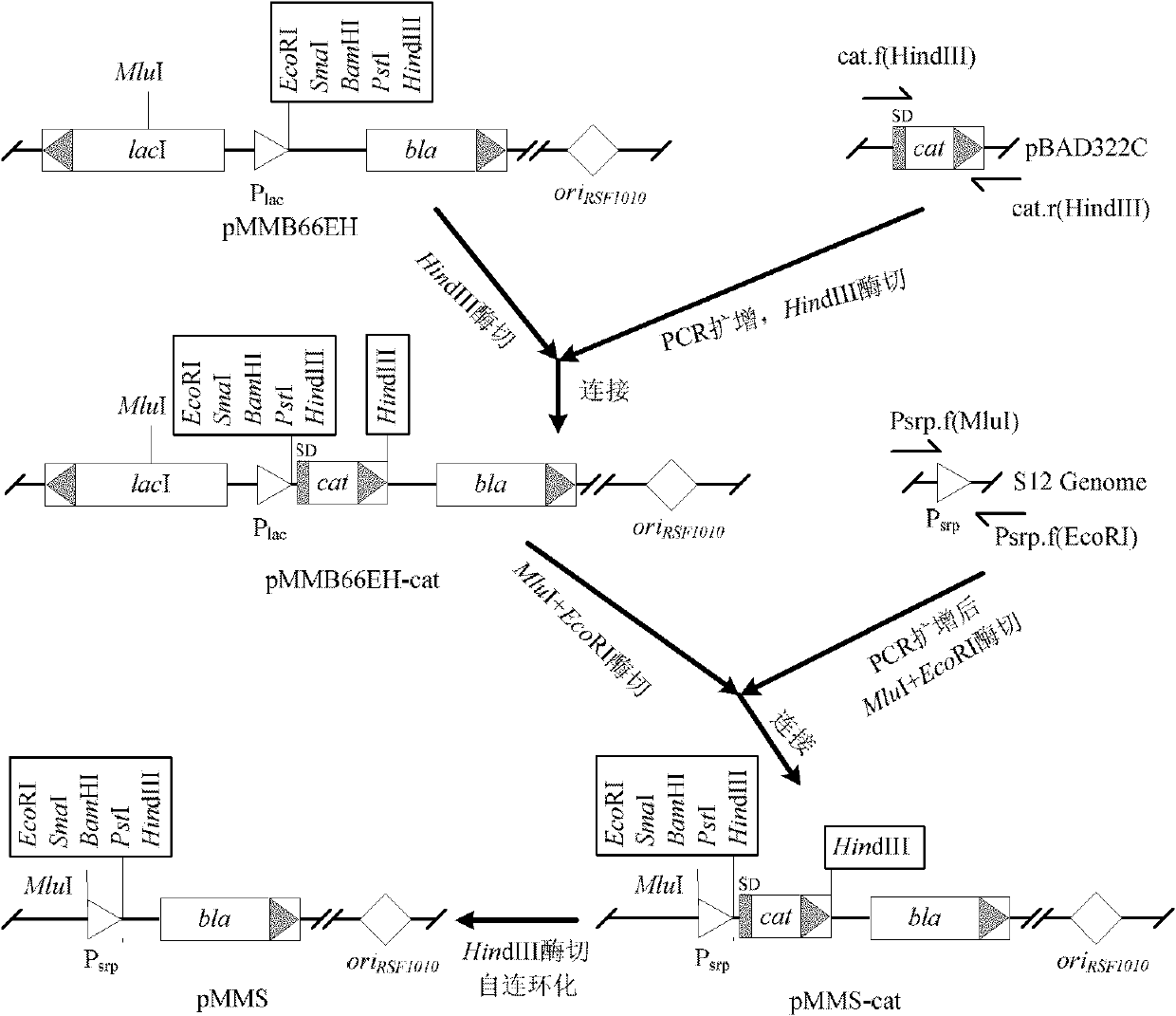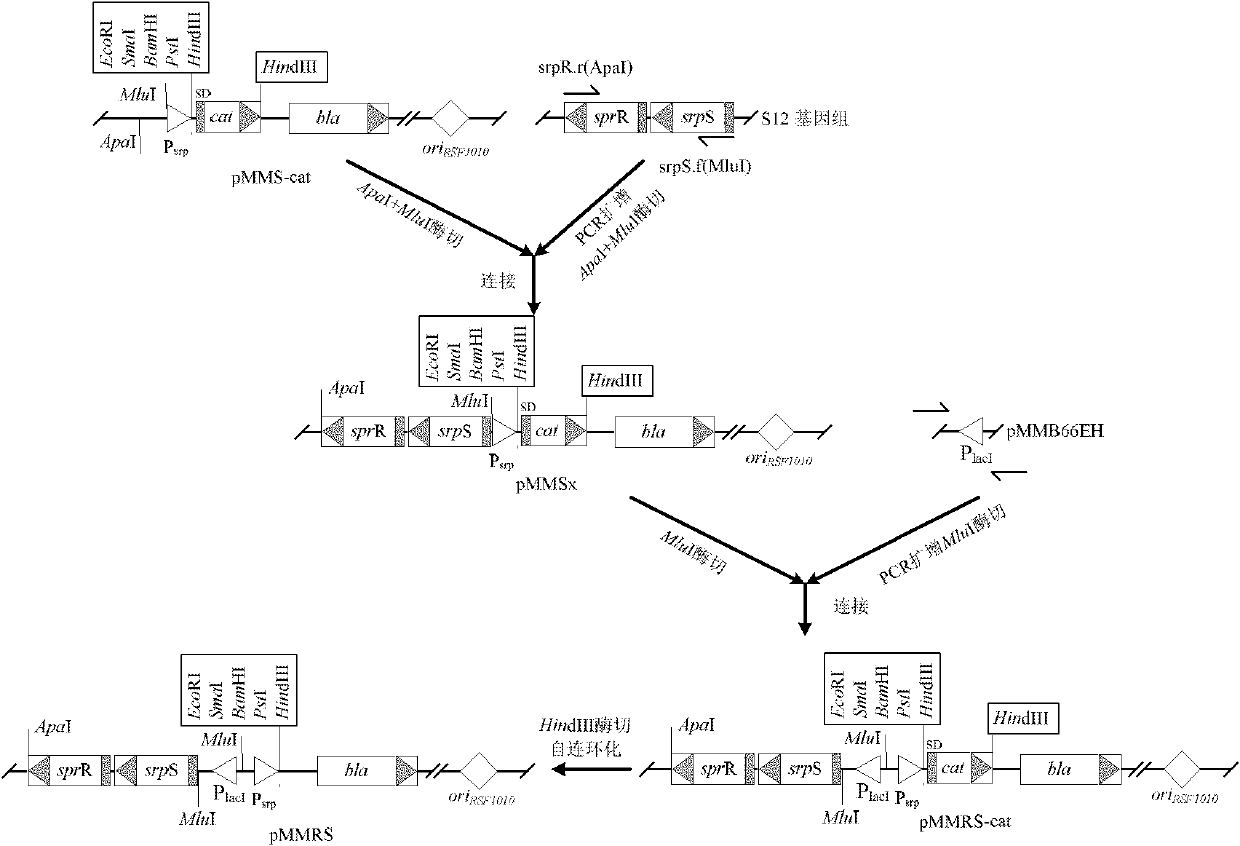Organic solvent responded expression vector and application thereof in biological catalysis
A technology of organic solvents and expression vectors, applied in the direction of using vectors to introduce foreign genetic material, recombinant DNA technology, bacteria, etc., can solve the problems of limited application and high price
- Summary
- Abstract
- Description
- Claims
- Application Information
AI Technical Summary
Problems solved by technology
Method used
Image
Examples
Embodiment 1
[0043] Construction of Organic Solvent Responsive Expression Vectors pMMS and pMMRS
[0044] promoter P srp Directing the expression of the organic solvent tolerance gene in strain S12 is a promoter that can be induced by a variety of organic solvent compounds. Most of these compounds are relatively cheap, and many of them are widely used in industry, such as n-hexane , cyclohexane and toluene. The heterologous expression system based on this promoter will undoubtedly be a good substitute for the lac promoter expression system. This embodiment uses the above P srp The promoter replaced the original promoter of pMMB66EH, and the expression vector pMMS ( figure 1 ). To this end, a reporter gene, chloramphenicol resistance gene cat, was inserted into the multiple cloning site of the wide host range vector pMMB66EH to construct pMMB66EH-cat. Then perform double digestion (MluI+EcoRI), and insert the promoter fragment extended by PCR from the S12 genome using Psrp.f (MluI) and...
Embodiment 2
[0050] Vector availability and host range
[0051] In order to further verify the correct host range of the vector construction, in this example, the vector constructed above was also introduced into each Pseudomonas in Table 1, and it was checked whether the vector could endow the host bacteria with the presence of an inducer (organic solvent). With chloramphenicol resistance, the results show that Pseudomonas containing pMMS-cat can grow on LB medium containing 5g / l chloramphenicol when the inducer is present, which shows that the constructed vector contains the correct target promoter sub, and has the ability to initiate the expression of downstream genes under solvent-induced conditions.
[0052] The impact of carrier pMMS-cat and pMMRS-cat on the chloramphenicol sensitivity of each bacterial strain when table 4 inducer (organic solvent) exists
[0053]
[0054] The results in Table 4 show that the vector pMMRS-cat can also endow various strains with resistance ...
Embodiment 3
[0056] Construction of dibenzothiophene desulfurization bacteria
[0057] Biological desulfurization is an environmentally friendly and energy-saving method for desulfurization of fossil fuels and a potential alternative to chemical desulfurization. The biological desulfurization of petroleum and petroleum refined fuel oil is generally carried out using an oil-water two-phase system, which is a type of two-phase biocatalysis. Fuel oil is a mixture of various organic solvent compounds, such as alkanes and aromatic hydrocarbons. Therefore, there is the same problem as the biphasic reaction in biological desulfurization, that is, the toxicity of organic solvents to cells. Previously, a recombinant solvent-tolerant desulfurization strain A4 was constructed with pMMB66EH, which contained the carrier pMMABCD, which was specifically described in the Chinese example patent application number 200610044410.1, the publication number CN1861785, and the publication date was November 15, 20...
PUM
 Login to View More
Login to View More Abstract
Description
Claims
Application Information
 Login to View More
Login to View More - R&D
- Intellectual Property
- Life Sciences
- Materials
- Tech Scout
- Unparalleled Data Quality
- Higher Quality Content
- 60% Fewer Hallucinations
Browse by: Latest US Patents, China's latest patents, Technical Efficacy Thesaurus, Application Domain, Technology Topic, Popular Technical Reports.
© 2025 PatSnap. All rights reserved.Legal|Privacy policy|Modern Slavery Act Transparency Statement|Sitemap|About US| Contact US: help@patsnap.com



